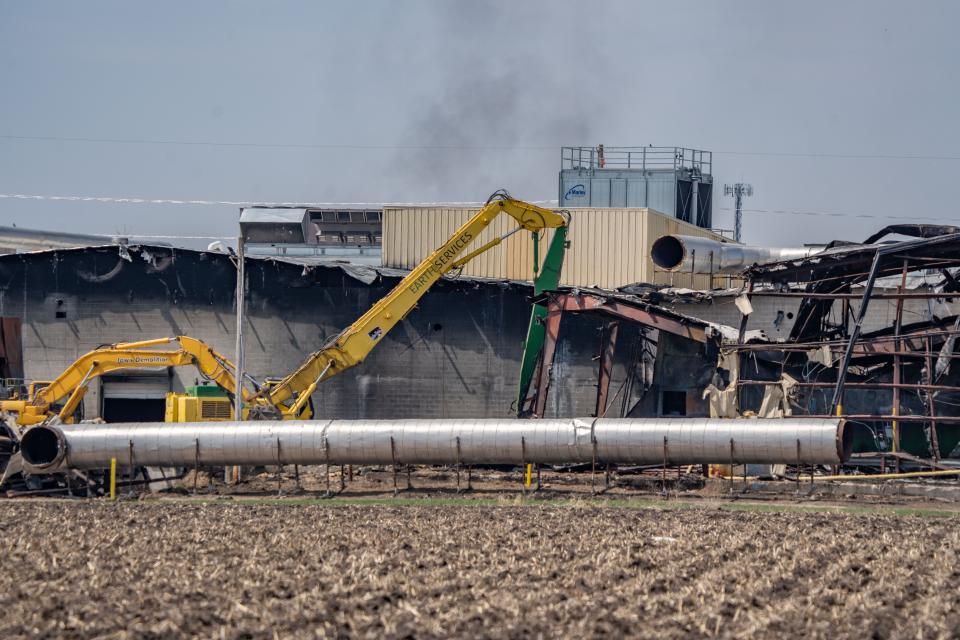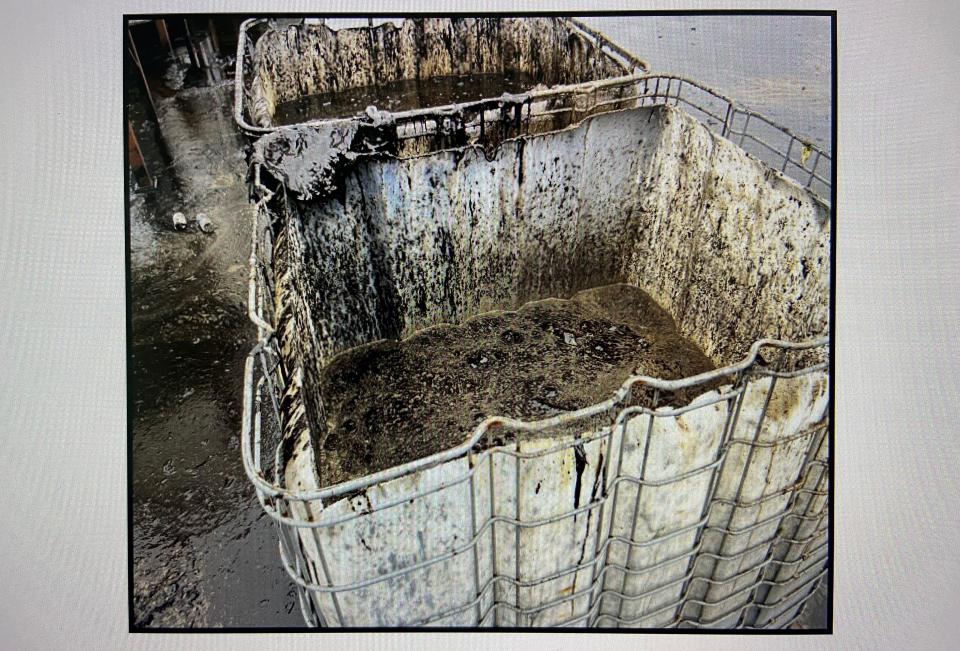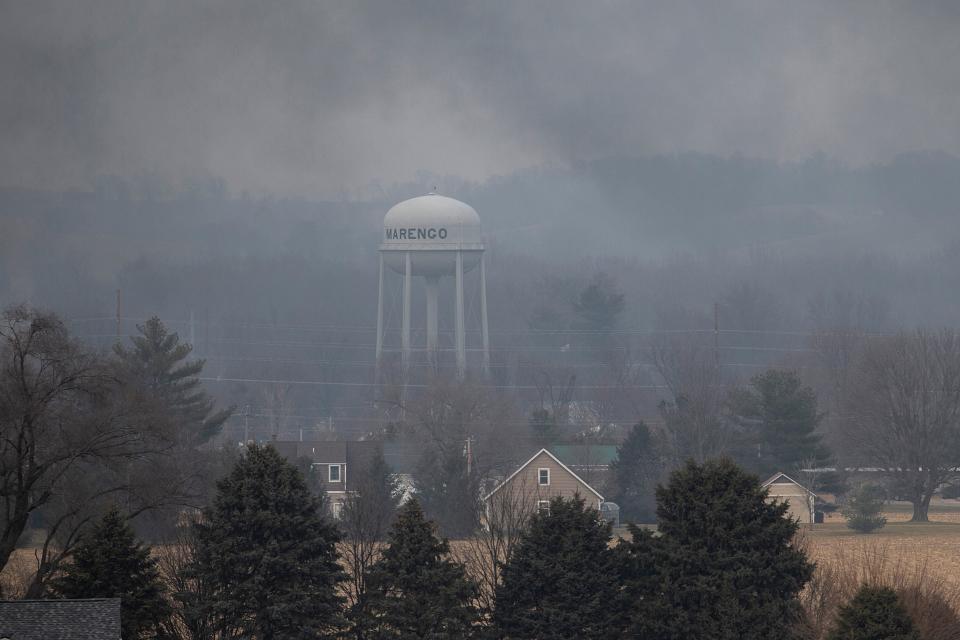Environmental Protection Agency takes oversight of Marengo explosion site cleanup
Part of an ongoing series
U.S. Environmental Protection Agency officials will step in for Iowa regulators to oversee the lagging cleanup of a Marengo asphalt shingle recycling factory that exploded last year.
State officials warned this week that hazardous chemicals may contaminate the area.
The blast and fire forced city residents to evacuate and left employees frightened about the possible impact on their health from unidentified and potentially toxic chemicals. In a letter to the EPA on Tuesday, Iowa Department of Natural Resources Solid Waste and Contaminated Sites Supervisor Michael Sullivan asked the federal regulators to "take removal action" concerning the lead, diesel and chemicals found in the water and dirt around the factory.
He also asked the EPA to assess the site, remove chemicals and dispose of tens of thousands of gallons of contaminated water.
Sullivan said the EPA needs to take over the area due to the "potential for a release of hazardous substances from haphazardly stored containers, the current unsecured nature of the building and its location in a populated area."
EPA spokesperson Shannan Beisser said Wednesday that agency officials in its Superfund program will work with the factory operator and site owner. The federal takeover comes almost five months after the Dec. 8 explosion, which set off a blaze that firefighters from throughout the region battled for 20 hours.

"EPA Region 7 will ensure that any immediate threats to human health and the environment are stabilized, and will work towards characterizing any additional hazards at the site," Beisser said in an email.
Experts told the Des Moines Register that, compared with state regulators, the EPA can inject more money into the cleanup process and ensure faster remediation. Agency officials can also levy criminal sanctions for any environmental violations by leaders of the company, C6-Zero.
Previously: Iowa sues company behind Marengo fire, asks court to compel cooperation in cleanup
"The EPA is scarier than the state," said Adam Babich, an environmental law professor at Tulane University.
The takeover follows an April 10 notice of violation that the EPA issued to C6-Zero for allegedly failing to give local emergency responders a list of chemicals at the factory prior to the explosion. The news also comes as C6-Zero and its environmental cleanup contractor, EcoSource, are more than two months behind a court-mandated deadline of Feb. 17 to test and remove contaminated water and soil.
The company is fighting battles on multiple fronts. The DNR denied EcoSource's request for a deadline extension April 10. At the same time, the department blocked EcoSource's attempt to remediate the site by hauling soil to a local landfill, with the DNR determining that the contractor has not properly tested the dirt for chemicals.
More stories from this series
Months after C6-Zero explosion, fire, ill ex-employees wonder what they were exposed to
'Vomiting on a daily basis': What workers say it was like inside C6-Zero before the explosion
C6-Zero denies significant use of carcinogen benzene before Marengo plant explosion, fire
C6-Zero and the DNR also are arguing about which group needs to remove contaminated water from a basin next to the factory. The Metro Waste Authority, meanwhile, revoked a permit that would have allowed EcoSource to bring contaminated water to a Mitchellville landfill, with an MWA spokesperson saying that the contractor initially gave the landfill officials "an incomplete characterization of the waste."
"I don't think anybody's comfortable with what contaminants are in there and what's not in there," said Jim Olson, a specialist at the Iowa Waste Reduction Center who has followed C6-Zero's cleanup effort. "They haven't done an acceptable job assessing either (soil or water)."
C6-Zero spokesperson Mark Corallo said the company welcomes the EPA's takeover. Earlier this week, he said that the DNR had "behaved in an arbitrary and capricious and obstructive manner toward C6-Zero."
“In stark contrast to our experiences with IDNR, C6-Zero has had a collaborative and cooperative relationship with both the Iowa Attorney General’s office and the EPA and as a result, cleanup at the Marengo site is moving toward completion," Corallo said. "We look forward to any assistance EPA can provide in the late stages of this process.”
Why did Iowa bring in the EPA Superfund division?

Established in 1980, the Superfund program allows the EPA to clean up hazardous substance emergencies and abandoned, uncontrolled toxic sites. After taking over the Marengo location for the DNR, EPA officials will assess the area and create a rating based on the severity of the chemical contaminants in the surrounding water and dirt.
EPA officials place the most seriously affected areas on their National Priorities List. Twelve sites in Iowa are on the list, including the former Dico factory south of downtown Des Moines, where employees made steel wheels and pesticides.
Don Elliott, an environmental law professor at Yale University and former EPA attorney, said state agencies often request help when a site is too complicated for their staffs to handle.
According to C6-Zero's written responses to EPA questions after the explosion, about 60,000 gallons of the oil product the company produced from shingles burned as a result of the blast. A safety data sheet that the company created for the product disclosed that overexposure to the chemical mix could cause brain damage. The document also disclosed that two of the mix's chemicals ― naphthalene and cumene ― are "reasonably anticipated" to cause cancer.
The safety data sheet for a company solvent, meanwhile, did not disclose much information about the chemicals it contains. About 40% of the mix is Aromatic 200, a collection of several potential compounds that refineries often capture while turning crude oil into fuel. The company described the other 60% of the mix as a "proprietary blend of solvents."
The day after the explosion, according to a report created by EcoSource, water samples found benzene in concentrations above state standards. Several researchers have concluded that benzene exposure causes leukemia and non-Hodgkin lymphoma.
"(States) want the larger staff and greater experience of the feds," Elliott said of an EPA takeover.
He added that states also bring in the EPA to wash their hands of political entanglements. In the months before the explosion, C6-Zero employed Jeff Boeyink, a lobbyist for LS2 Group and former chief of staff to then-Iowa Gov. Terry Branstad.
Iowa Attorney General Brenna Bird, whose office sued C6-Zero in January for missing cleanup deadlines, previously served as legal counsel for LS2 Group, according to a January 2022 Cedar Rapids Gazette article. A spokesperson for Bird's office has not responded to multiple Register emails since the beginning of March, asking whether Bird has recused herself from involvement in the case. (Update: See note at bottom of this article.)

Superfund division has a lot more money for cleanup than Iowa DNR
Elliott said states also request the EPA's assistance because the federal government has more money.
In February, the DNR agreed to pay up to $834,000 for a contractor to remove water from a basin next to the factory. But the agency tapped federal funds allocated to the state through the American Rescue Plan Act, a COVID-19 relief bill. Otherwise, the DNR pays for site cleanup through its Hazardous Waste Fund, which as of June 2022 had a balance of $328,000.
"That's not an awful lot of money to do a cleanup," Elliott said.
The EPA's Superfund division, on the other hand, reported about $18.8 billion in assets at the end of September, including an unobligated balance of about $6.2 billion. The federal government funds the division through an annual allocation and company fines.
In November 2021, Congress reimplemented a special tax on chemical companies to support the Superfund division. Congress created the tax in 1980, but lawmakers allowed the levy to expire in 1995.
The division also receives money from states. When agencies like DNR ask the EPA to take over contaminated sites, the state agencies agree to fund about 10% of any cleanup costs.
Babich, the Tulane university professor, said the EPA tends to be more aggressive than state agencies in referring cases to prosecutors. He added that prosecutors are interested in criminal charges when potential environmental violations lead to deaths or serious injuries.
During the Dec. 8 explosion, two C6-Zero employees suffered severe burns. Marengo Police Chief Ben Gray said the workers remained at the University of Iowa Hospitals & Clinics burn unit for "several weeks."
"Frankly, they could be looking at criminal liability as well as civil liability," Babich said. "It's kind of a bigger hammer."
Editor's note: After publication, a spokesperson for Attorney General Brenna Bird's office sent the Register the following statement:
It is the Attorney General’s responsibility to enforce the law. Attorney General Bird sued C6-Zero in January to force them to comply with an emergency order. She has never represented C6-Zero and has no current relationship with LS2group. Attorney General Bird will continue taking the steps necessary to uphold the rule of law.
Tyler Jett is an investigative reporter for the Des Moines Register. Reach him at tjett@registermedia.com, 515-284-8215, or on Twitter at @LetsJett. He also accepts encrypted messages at tjett@proton.me.
This article originally appeared on Des Moines Register: Marengo explosion site cleanup to be overseen by EPA

